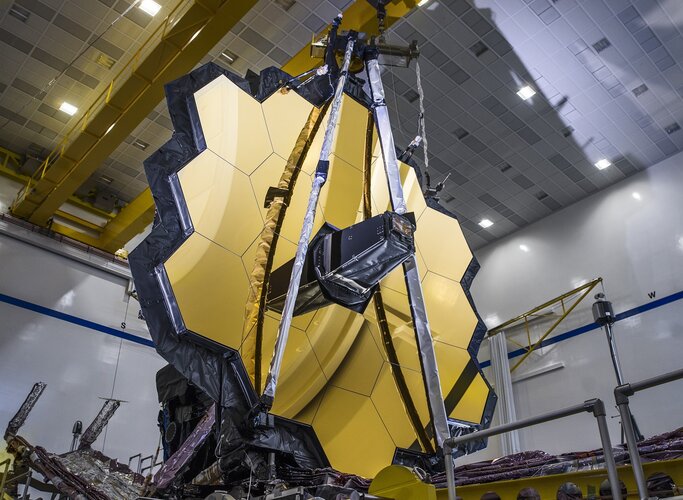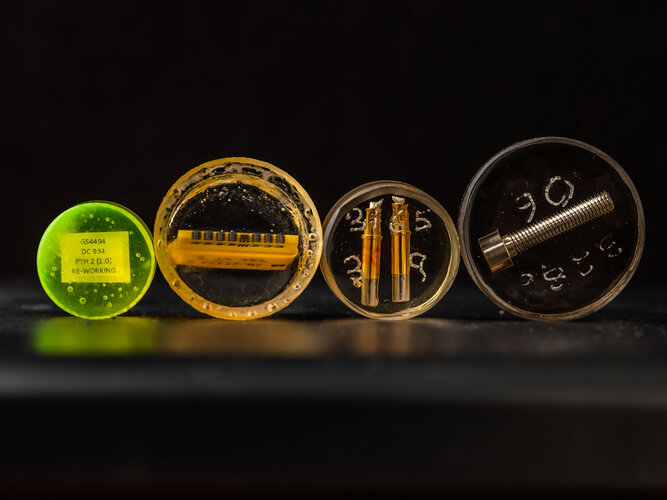
Copernical Team
Three of the four instruments on NASA's Webb telescope ready for science

Cosmic targets for Webb Telescope’s first images announced

The NASA/ESA/CSA James Webb Space Telescope will soon reveal unprecedented and detailed views of the Universe, with the upcoming release of its first full-colour images and spectroscopic data.
Discs for fault detection
 Image:
Discs for fault detection
Image:
Discs for fault detection Week in images: 04-08 July 2022

Week in images: 04-08 July 2022
Discover our week through the lens
Using lasers and 'tow-trucks', Japanese firms target space debris

From laser beams and wooden satellites to galactic tow-truck services, start-ups in Japan are trying to imagine ways to deal with a growing environmental problem: space debris.
Junk like used satellites, parts of rockets and wreckage from collisions has been piling up since the space age began, with the problem accelerating in recent decades.
"We're entering an era when many satellites will be launched one after another. Space will become more and more crowded," said Miki Ito, general manager at Astroscale, a company dedicated to "space sustainability".
"There are simulations suggesting space won't be usable if we go on like this," she told AFP. "So we must improve the celestial environment before it's too late."
The European Space Agency (ESA) estimates that around one million pieces of debris larger than a centimeter—big enough to "disable a spacecraft"—are in Earth's orbit.
SwRI demonstrates machine learning tool to efficiently process complex solar data
 Big data has become a big challenge for space scientists analyzing vast datasets from increasingly powerful space instrumentation. To address this, a Southwest Research Institute team has developed a machine learning tool to efficiently label large, complex datasets to allow deep learning models to sift through and identify potentially hazardous solar events. The new labeling tool can be applied
Big data has become a big challenge for space scientists analyzing vast datasets from increasingly powerful space instrumentation. To address this, a Southwest Research Institute team has developed a machine learning tool to efficiently label large, complex datasets to allow deep learning models to sift through and identify potentially hazardous solar events. The new labeling tool can be applied Shenzhou-14 Taikonauts conduct in-orbit science experiments, prepare for space walks
 Scientific endeavors aboard China's space station are expected to bear fruits, as the Shenzhou-14 taikonauts have devoted more time to microgravity experiments on the orbiting core module Tianhe since entering it a month ago.
China's space station is designed to be a versatile space lab, capable of accommodating 25 experiment cabinets for scientific exploration. The China Manned Space Agen
Scientific endeavors aboard China's space station are expected to bear fruits, as the Shenzhou-14 taikonauts have devoted more time to microgravity experiments on the orbiting core module Tianhe since entering it a month ago.
China's space station is designed to be a versatile space lab, capable of accommodating 25 experiment cabinets for scientific exploration. The China Manned Space Agen Meet NASA's Orion Spacecraft
 On NASA's Artemis missions, a unique spacecraft will take flight. Orion, NASA's newest spacecraft built for humans, is developed to be capable of sending astronauts to the Moon and is a key part of eventually sending them on to Mars.
An uncrewed Orion will be tested on Artemis I and travel 40,000 miles past the Moon, farther than any spacecraft built for humans has gone before. This missio
On NASA's Artemis missions, a unique spacecraft will take flight. Orion, NASA's newest spacecraft built for humans, is developed to be capable of sending astronauts to the Moon and is a key part of eventually sending them on to Mars.
An uncrewed Orion will be tested on Artemis I and travel 40,000 miles past the Moon, farther than any spacecraft built for humans has gone before. This missio CAPSTONE deploys from Rocket Lab Lunar Photon into Lunar Transfer Orbit
 Terran Orbital Corporation (NYSE: LLAP), a global leader in satellite solutions, primarily serving the United States and Allied aerospace and defense industries, has announced the successful deployment of the CAPSTONE spacecraft from a Rocket Lab Lunar Photon into a Lunar Transfer Orbit.
The Terran Orbital designed, built, and integrated Cislunar Autonomous Positioning System Technology Op
Terran Orbital Corporation (NYSE: LLAP), a global leader in satellite solutions, primarily serving the United States and Allied aerospace and defense industries, has announced the successful deployment of the CAPSTONE spacecraft from a Rocket Lab Lunar Photon into a Lunar Transfer Orbit.
The Terran Orbital designed, built, and integrated Cislunar Autonomous Positioning System Technology Op SpaceX ties record for reused Falcon 9 rocket on 50th Starlink launch
 SpaceX launched one of its Falcon 9 rockets for the 13th time Thursday morning, tying a company record for the reusable rocket.
The California space exploration company's Falcon 9 rocket conducted a perfect launch, carrying 53 of its Starlink satellites from Space Launch Complex 40 at Cape Canaveral Space Force Station in Florida.
This was the 50th launch of Starlink satellites f
SpaceX launched one of its Falcon 9 rockets for the 13th time Thursday morning, tying a company record for the reusable rocket.
The California space exploration company's Falcon 9 rocket conducted a perfect launch, carrying 53 of its Starlink satellites from Space Launch Complex 40 at Cape Canaveral Space Force Station in Florida.
This was the 50th launch of Starlink satellites f 
